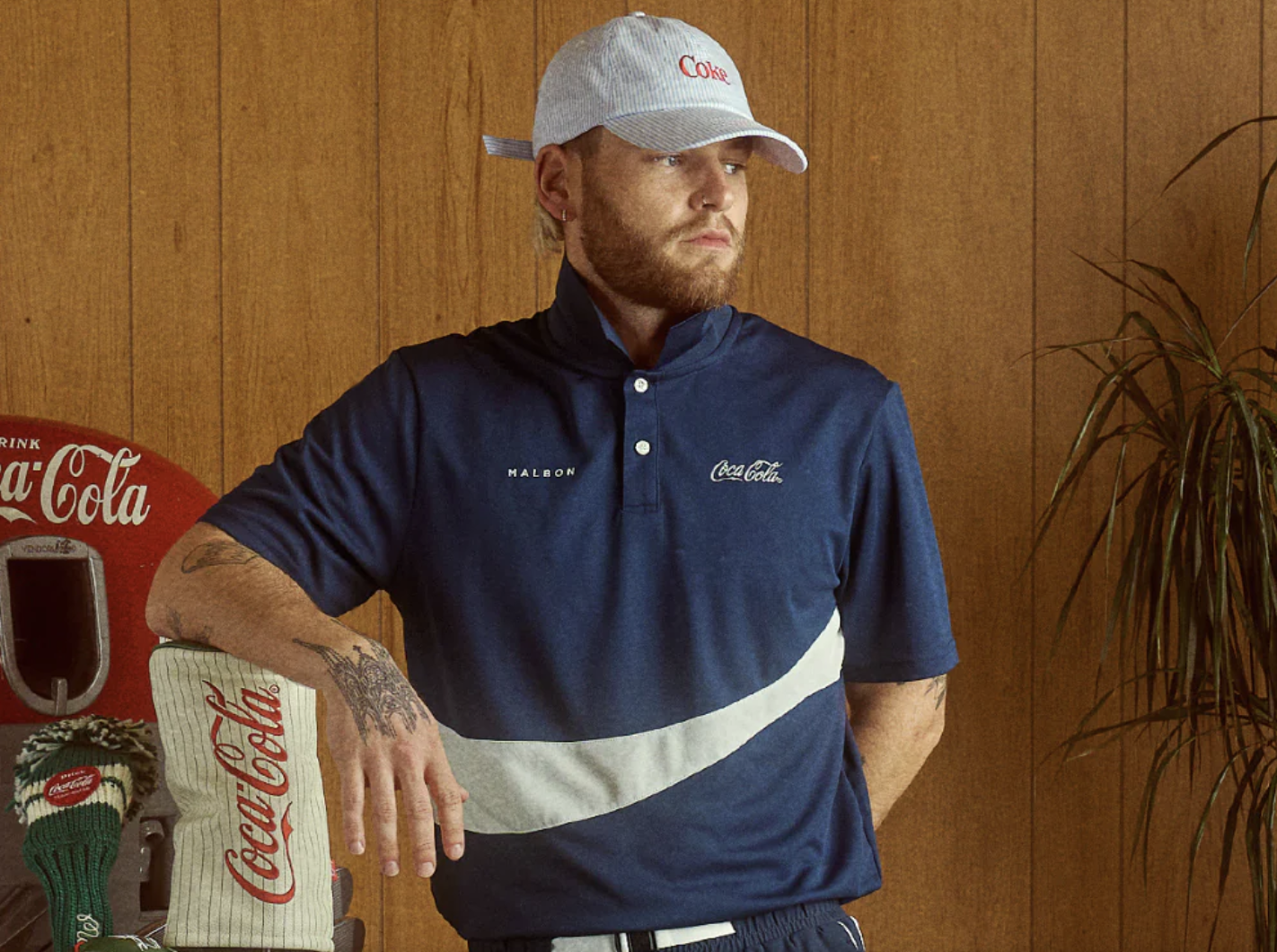From Streetwear Dreams to Putting Greens: The Rise of Malbon Golf and its Big Swing with Jason Day
Forget stuffy polos, Jason Day just made the ultimate power move: joining Malbon Golf. Learn how this streetwear-inspired brand is redefining golf fashion, breaking barriers, and building a vibrant community.
In the world of golf, tradition reigns supreme. But amidst the plaid pants and pristine courses a new trend is gaining traction, courtesy of a brand with its roots firmly planted in the world of streetwear: Malbon Golf. Founded by brothers Stephen and Erik Malbon, the company is shaking up the golfing landscape with its bold designs, innovative approach, and now, a major development – signing PGA Tour star Jason Day.
Jason Day has signed with Malbon Golf.
Humble Beginnings with a Streetwear Soul
The Malbon brothers' love for golf stemmed from their father, a passionate player who instilled in them a respect for the game. However, they felt something was missing: a style that reflected their own youthful energy and streetwear sensibilities. In 2015, with Stephen's background in fashion and Erik's business acumen, Malbon Golf was born.
Their initial offerings were a far cry from the typical golf attire. Think vibrant colors, unexpected patterns, and relaxed silhouettes – think less Augusta National, more Venice Beach. This unorthodox approach resonated with a younger generation of golfers who craved individuality and expression on the course.
Innovation Meets Performance
But Malbon Golf wasn't just about flashy looks. The brothers understood that performance was paramount. They partnered with cutting-edge fabric manufacturers and incorporated functional elements like moisture-wicking technology and flexible materials. The result? Apparel that was both stylish and comfortable, allowing golfers to move freely and focus on their game.
Breaking Barriers and Building a Community
Malbon Golf's impact extended beyond the course. They actively challenged the sport's elitist image, making it more inclusive and accessible. Through collaborations with diverse creators and athletes, they fostered a sense of community among golfers who felt overlooked by traditional brands.
Their efforts resonated with a wider audience, attracting the attention of celebrities like Justin Timberlake and J.R. Smith, who became vocal supporters of the brand. Malbon Golf's social media presence exploded, fueled by eye-catching visuals and authentic storytelling.
A Major Signing Shakes the Golf World
In late 2023, the golf world was sent into a tizzy when news broke that Jason Day was leaving his longtime sponsor, Nike, to join Malbon Golf. In a way this move fueled the flames of other Nike staffers — like Tiger Woods — potentially making the jump as well. This wasn't just any endorsement deal; it was a seismic shift, signifying a changing of the guard within the industry.
Day, known for his powerful swing and infectious personality, is a perfect fit for Malbon Golf's image. His decision to switch sponsors speaks volumes about the brand's growing influence and appeal. It's a validation of their unique approach and a testament to their dedication to building a community that transcends generations and traditions.
The Future of Golf: Where Style Meets Substance
Malbon Golf's trajectory is only heading upwards. With Day on board, their reach and influence are poised to skyrocket. Their focus on innovation, performance, and inclusivity is sure to attract a new wave of golfers to the sport.
As Malbon Golf continues to rewrite the rules of golf fashion, one thing remains clear: the future of the game is looking a lot more colorful, a lot more comfortable, and a whole lot more fun. Whether you're a seasoned pro or a weekend warrior, Malbon Golf invites you to step onto the course and express yourself, one swing at a time.
Malbon Golf's story is one of passion, innovation, and disruption. From its humble streetwear roots to its partnership with a golfing superstar, the brand is changing the face of the game, one colorful polo shirt at a time. As they continue to grow and evolve, one thing is certain: Malbon Golf is more than just a clothing brand; it's a movement, and it's here to stay.
8 Wastes in the Golf Equipment Industry
 The current state of the golf equipment manufacturing industry is a wasteland. As companies turn out more and more clubs into the marketplace, customers are hard-pressed to keep up with all of this 'innovation' and 'performance' flashing across their TV screens, golf magazines and laptop monitors. Sorry friends, but the golf equipment industry needs an enema.
The current state of the golf equipment manufacturing industry is a wasteland. As companies turn out more and more clubs into the marketplace, customers are hard-pressed to keep up with all of this 'innovation' and 'performance' flashing across their TV screens, golf magazines and laptop monitors. Sorry friends, but the golf equipment industry needs an enema.
Not entirely unlike the 'Seven Deadly Sins', there are 8 wastes found in industries across the globe: Transport, Inventory, Motion, Waiting, Over-production, Over-processing, Defects (Rework), and Skills (Human Intellect). Eliminating or reducing these wastes from the golf equipment industry would not only streamline processes and increase customer satisfaction, but it could very well save the industry itself.
Here are eight examples of each type of waste within the golf equipment industry as I see it.
Transport
Whenever you have an excessive amount of people, products or information moving around a process, you are dealing with waste. Think about all of the different places you can purchase a golf club. You've got brick & mortar major sporting dealers (Dick's, Sports Authority, etc.), golf-specific stores (Golf Galaxy, Golfsmith), second-hand sporting good shops, and this little thing called the Internet. The omni-channel model of combining multiple retail sources just compounds the issue.
If OEMs want to help solve the way their industry is perceived, they need to first limit the places their products are moving, not increase them. I know that sounds counter-intuitive, but less is more in this case.
Inventory
This should be obvious. Anyone who has taken five minutes of an Economics class knows the concept of supply and demand. If you carry more inventory than what your customers need, you run the risk of your products expiring or cannibalizing themselves. That's waste in a nutshell, really.
All of those drivers and iron sets you see "priced to sell" that were once at full price only 4 months ago? That's excessive inventory, which costs money to store, and even more money to throw away. (See: Dick's Sporting Goods laying off all of their PGA pros.)
Motion
Similar to Transport, the waste of motion deals specifically with excessive moving parts within a process or task. Think about all the steps you -- personally -- have to go through in order to buy a new golf club. First you have to learn about the new product. Next, you have to find the product's price. Then you probably want to test it out at a store. You might need to also get fit for the club. If it's an adjustable driver, you'll also want to tinker with the loft, swing-weight and whatever else. All of that excessive motion needs to be done before you even buy the damn thing.
Want to cut down on all of that motion? Simplify golf club technology and increase accessibility of product testing. A one-stop shop is ideal.
Waiting
Any time you have to wait for something to occur before another step can take place in a process, waste is growing. Admittedly, OEMs have done a pretty decent job with cutting down how long you have to wait before you get their product in your hands. There's always room for improvement, however.
The waste of Waiting can also be delayed (pun intended). Whenever a new golf club is announced by your favorite brand, you may be tempted to "wait" for prices to drop on "older" equipment. Every day that goes by before prices drop is a day where you -- the customer -- keep your wallet shut. Want to decrease excessive inventory while increasing sales? Lower prices a full month before the next product is announced.
Over-Production and Over-Processing
I'm grouping these two wastes together because they are very similar in most industries. Similar to Inventory, supply and demand dictates how bad these wastes can be for a product. A good analogy for Over-production is to compare McDonald's against a high-end restaurant. Mickey-D's makes a ton of hamburgers every morning in preparation for that day's customer volume (even though they really don't know how many people will walk through the door). At the end of the day, any burgers that aren't purchased get thrown away. Conversely, most restaurants are "made-to-order" and only make food at the time of order. Sound similar to golf clubs being pushed down your throat?
Over-processing is similar such that high-grade materials and features are being used when less fancy items would do just fine. I guarantee you that amateur golfers cannot tell the difference between a standard driver and an adjustable driver. Why do we need to move weights around and change our driver's center-of-gravity? Seems pretty wasteful to me. And expensive.
Defects (Rework)
This is, in my opinion, one of the biggest wastes currently seen in the equipment industry. While golf clubs might not be defective in the truest sense of the word, there is a TON of rework that occurs every single time a new club is released.
Be honest with yourself: is there really that big a difference between the TaylorMade SLDR and TaylorMade JetSpeed? Sure, there are a few different moving parts here and there, but such small details are hardly reason enough to shell out another $400. The same can be said for almost every new iron, wedge, putter or wood that comes off the assembly line. Increase the time between product releases to allow for true innovation to breathe.
Skills (Human Intellect)
Last but certainly not least is the waste of Skills, also commonly known as the waste of Human Intellect. The concept of Hack Golf and crowdsourcing was started to combat this waste, which describes any time you aren't tapping into your people's (or customer's) knowledge base.
Golf OEMs are comprised of some very, very intelligent people. I've met many of them. I enjoy speaking to all of them. And, more often than not, all of them also play golf. It would be foolish for the golf equipment industry to ignore the pain points golfers feel when purchasing new clubs, and I suspect they are finally getting the message.










